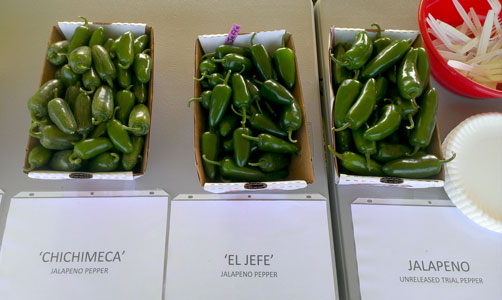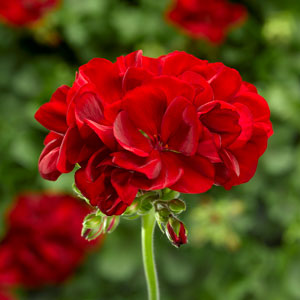11/1/2017
Standing the Test of Time
Katie Elzer-Peters
Are you looking for fantastic plants that consumers are practically guaranteed to successfully grow? Trying to decide what to stock that will fly off the shelf? Put down the marketing brochures and let your fingers do the walking to the All-America Selections (AAS) website (all-americaselections.org). There you can check out their winners, and, if something catches your eye, ask your broker for the seeds or enlist a grower to produce plants for next season.
“Many retailers are already selling AAS and they don’t even realize it,” says Diane Blazek, Executive Director of All-America Selections. That means you’re not taking advantage of free signage and POP materials developed for download, printing and displaying in order to drive sales. (Look under the “Industry” tab on their website.)
AAS, (founded in 1932) has, for 85 years, been conducting the only comparative blind plant evaluation trials across the United States and Canada on new, un-introduced plant varieties. Each year, judges at around 80 trial locations study plants in the following categories:
- Ornamentals from Seed
- Ornamentals from Vegetative Cuttings
- Edibles (fruits and vegetables from seed)
- Herbaceous Perennials (first winners to be announced in 2019)
There’s no set number of winners to be announced each year. Plants that meet the criteria and thresholds after extensive trialing across a variety of conditions nationally become national winners. Varieties that perform in specific regions become regional winners, a distinction added in 2014 that has opened the door for spectacular, regionally-appropriate plants to get recognition and retailers to have a reliable list of plants that will grow well in their locations.
How the AAS Trials Work
Breeders pay a fee to enter plants into the trial, which pays for the trial logistics. Plants entered into the trials must be un-introduced to market and meet specific thresholds of availability of seeds or cuttings, so that consumers will be able to buy the plants if they’re selected as winners.
Breeders provide the seed or cuttings for the trials in packages marked only with the plant type and entry number—not the breeder name or any identifying characteristics, so that the trials truly stay “blind.” Pamela Bennett, County Co-Director, Extension Educator and State Master Gardener Volunteer Coordinator at The Ohio State University, summed up what makes the AAS trials and selections special.
“What I appreciate about this trial program it that it is about as fair and non-biased as you can get,” she notes. “Trials of this nature can be very subjective, especially if people know where the plants came from, but with AAS, the data goes to the accountant and AAS doesn’t see any of it until it has been tabulated. It is all impartial, aboveboard and professional, in terms of implementation.”
 Pictured: All potential AAS-winning varieties are evaluated against successful, long-established comparison plants to ensure that new varieties meet their claims and are truly breakthroughs in their categories.
Pictured: All potential AAS-winning varieties are evaluated against successful, long-established comparison plants to ensure that new varieties meet their claims and are truly breakthroughs in their categories.
Rob Johnson, Founder and Chairman of Johnny’s says, that, because of the blind trials, “AAS also provides an important opportunity to the smaller breeding companies to compete and potentially have a national winner.” Nobody is swayed by marketing rhetoric or pre-conceived opinions about breeding companies. We all get the benefit of enjoying spectacular new plants from smaller companies that might not have been able to get attention for their breakthrough genetics otherwise.
At the point of entry, breeders submit “claims” or information about how this new variety performs above and beyond established varieties or how the variety is completely unique to other varieties on the market They also list their own comparison varieties, for example, “My tomato plant A blooms XX days earlier than plant B, XX days earlier than plant C, and XX days earlier than plant D.” A committee selects the comparison varieties to be used in the trial. New trial plants are grown and evaluated on their own merits and against the two or three successful, well-established comparison varieties.
What it Takes to Be a Winner
There has to be something special about the new variety for it to be a winner. Patty Buskirk, an AAS judge and owner of Seeds by Design, says, “AAS does not want to dilute its brand. It wants to deliver on its promise. We don’t want to award something that isn’t better than what is already on the market.”
A unique growth habit, fruit flavor or color, or claim to fame is important, but it isn’t enough. Being a strong performer overall is important to being considered as a winner. “Even if the harvest tastes amazing and the plant meets the criteria for claims of uniqueness, if the plant looks gross, we’re not going to want to tell people to plant the plant in their yards,” says Jessie Liebenguth from Iowa State.
Put AAS Results to Work for You
 All funding for AAS organizational expenses and public relations initiatives come from assessments on sales of winners. “Ray Hastings, who founded AAS, was a smart man,” notes Diane, who has been the director of All-America Selections since 2009. That agreement sets up a mutual interest for both the organization and the breeders to promote the winners and increase sales of the plants.
All funding for AAS organizational expenses and public relations initiatives come from assessments on sales of winners. “Ray Hastings, who founded AAS, was a smart man,” notes Diane, who has been the director of All-America Selections since 2009. That agreement sets up a mutual interest for both the organization and the breeders to promote the winners and increase sales of the plants.
Pictured: Geranium Calliope Medium Dark Red is a 2017 AAS Ornamental Vegetative Winner. Plants tested well in high heat and drought conditions.
This arrangement works out well for retailers of the plants, too. More plants sold = more money for AAS to use on promotion of the winners = more chance that consumers will hear about them (and ask you about them) = more money in your pockets. These are plants you can feel good about recommending, too, because they’ve been thoroughly vetted.
Diane and her staff have been diligent over the past seven years to modernize the procedures of AAS to make it easier for the volunteer judges to submit information and to spread the word about the winners via social media, email PR, an updated, easy-to-use website with videos suitable for streaming in garden centers, and other initiatives.
Steven Poppe, a judge from the University of Minnesota Western Research Station, says, “It’s amazing that a nonprofit that’s been around for 85 years is still going strong like this.” For the industry’s sake, let’s help it keep going for another 85. It will only benefit all of us. GP
What is All-America Selections? (AAS)
AAS is the only non-profit plant trialing organization in North America.
Mission Statement
“To promote new garden varieties with superior garden performance judged in impartial trials in North America.”
Purpose
To test new, unsold cultivars
To inform gardeners about the AAS Winners
To earn gardeners’ trust in the AAS Winners
Grow an AAS Display Garden
Display Gardens of winners are a big part of public relations for AAS, introducing customers to the plants, and showing how fantastically they perform in the garden. Display gardens are not trial gardens; you don’t have to do any judging. You just plant the plants, talk to customers about them and enjoy! AAS will provide seed for the current winners and the winners from the previous four years, along with a sign for the garden. All you need to do is label the plants (with AAS-provided labels or your own) and answer any questions about the AAS varieties.
For more information contact All-America Selections at (630) 963-0770. GP